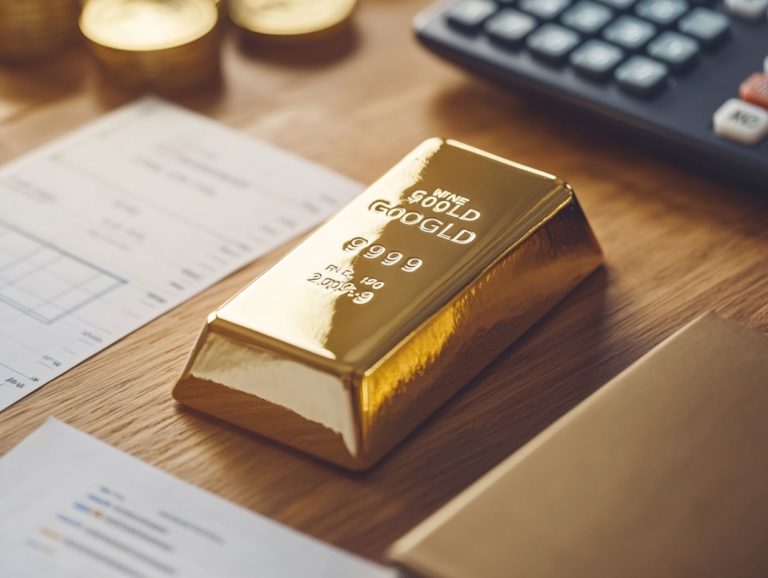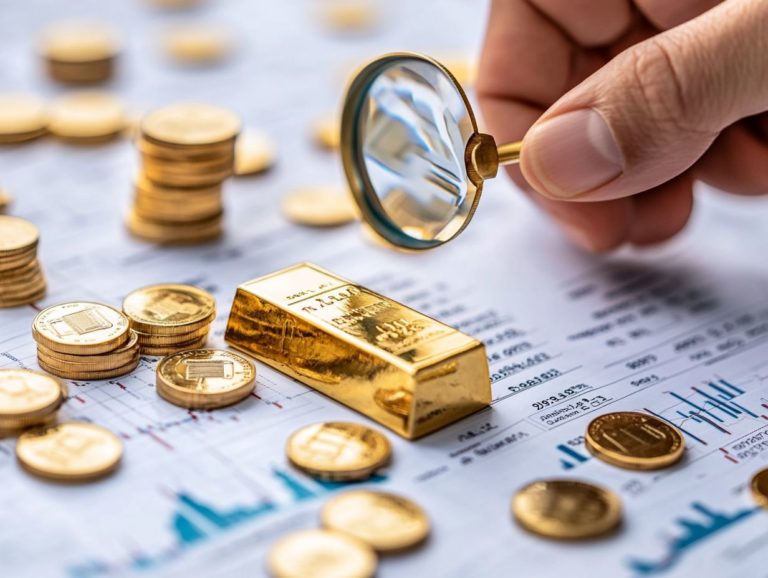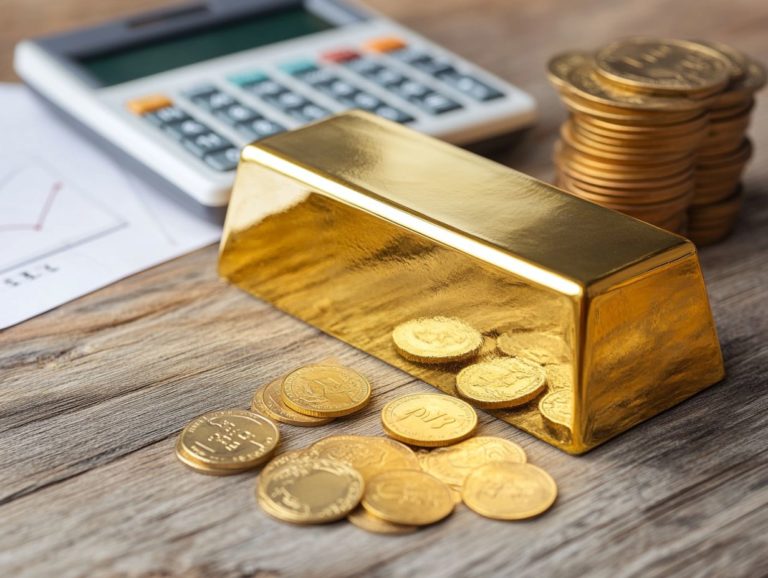The Rise of Gold Prices: Factors to Consider
Gold has been viewed as a safe haven during periods of economic uncertainty. The recent trends in gold prices certainly highlight this timeless allure.
This article delves into the historical context of gold pricing and examines the economic and political factors that shape its value. It also discusses the dynamics of supply and demand.
If you’re contemplating an investment in gold, you’ll find effective strategies outlined here. Additionally, predictions for future price movements will be discussed.
Dive in as you uncover the intricacies of gold investment. Discover what it could mean for your financial future.
Contents
- Key Takeaways:
- Overview of Gold Prices
- Factors Affecting Gold Prices
- Investing in Gold
- Predictions for Future Gold Prices
- Frequently Asked Questions
- What are some factors that contribute to the rise of gold prices?
- Curious about how economic uncertainty affects gold?
- Discover why inflation matters for gold prices!
- How does political instability impact the rise of gold prices?
- Why is demand from investors a significant factor in gold prices?
- Are there any other factors to consider when looking at the rise of gold prices?
Key Takeaways:
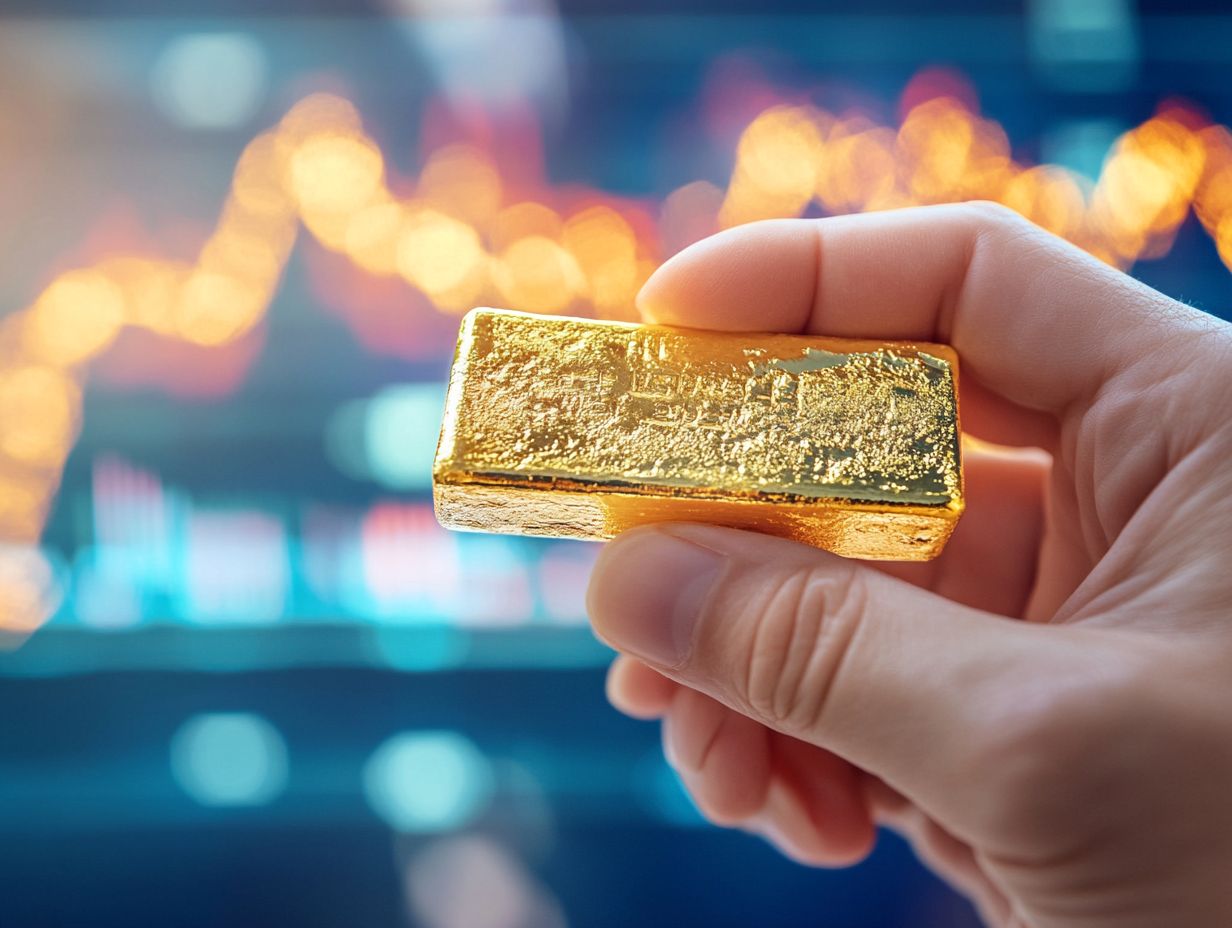
- The rise in gold prices can be attributed to a combination of economic and political factors, as well as supply and demand dynamics.
- Investing in gold requires careful consideration of various strategies and market trends, along with expert opinions and forecasting methods.
- While future gold prices may be unpredictable, many experts believe that gold remains a valuable asset for diversification and protection against inflation.
Overview of Gold Prices
The Overview of Gold Prices explores the intricate relationship between gold prices and a variety of economic factors, including the influence of central banks and interest rates.
Gold has historically been regarded as a safe-haven asset, particularly during times of economic instability.
These inflationary pressures play a significant role in shaping gold price trends. By grasping the historical context of gold prices, you gain valuable insights into current market conditions, giving you the power to make informed decisions about your gold investment options.
Recent Trends and Historical Context
Recent trends in gold prices reveal significant changes driven by historical events and economic indicators.
The intricate relationship between supply and demand dynamics is pivotal in this ever-evolving landscape. Key moments such as economic crises, geopolitical tensions, and inflationary pressures have heightened demand for gold.
Take, for example, the 2008 financial crisis; investors rushed to gold to safeguard their wealth. This pushed its prices to record highs.
Conversely, an uptick in gold mining output or breakthroughs in alternative materials can impact supply. This leads to shifts in pricing trends.
Understanding these interconnected factors helps you gain valuable insights into how current events may shape the future of the gold market.
Factors Affecting Gold Prices
Understanding the various economic and political influences that significantly impact gold prices is essential for you as an investor.
By grasping the underlying factors that drive changes in the value of this precious metal, you can make informed decisions.
Economic and Political Influences

Economic and political influences play crucial roles in shaping the price of gold, reflecting broader market conditions and the prevailing investor sentiment.
Central bank policies, particularly those from the Federal Reserve regarding interest rates, can greatly impact gold values.
When interest rates rise, the opportunity cost of holding non-yielding assets like gold increases, affecting demand.
During periods of economic uncertainty such as geopolitical tensions in Ukraine or the Middle East investors often seek gold as a safe-haven asset.
This surge in demand elevates gold’s reputation as an effective protection against rising prices. This interplay emphasizes the delicate balance between market dynamics and geopolitical shifts.
Supply and Demand Dynamics
The dynamics of supply and demand play a pivotal role in shaping gold prices. Fluctuations are influenced by various factors, including gold production and global demand.
On the supply side, mining operations employ a range of production methods, from artisanal mining to large-scale industrial techniques. As these methods evolve or encounter challenges like regulatory changes and resource depletion, the availability of gold can shift dramatically.
On the flip side, demand is equally powerful, particularly fueled by jewelry consumption and investment interests. An uptick in demand from emerging markets or a trend toward gold as a safe-haven investment can exert significant pressure on supply, driving prices higher.
Therefore, keeping a close eye on developments in both supply and demand is essential for understanding fluctuations in gold s market value.
Investing in Gold
Thinking about investing in gold? You’re in the right place! Investing in gold presents various opportunities tailored to your unique investment interests.
These options encompass strategies that align seamlessly with how you distribute your money, financial goals, and risk tolerance. This approach allows you to navigate the market with confidence.
Strategies and Considerations
Developing an effective investment strategy for gold involves careful consideration of market conditions and your personal risk tolerance.
This multifaceted approach underscores the necessity of diversification within your investment portfolio, promoting stability and minimizing potential losses during times of market volatility.
Weighing the benefits of long-term holdings against the allure of short-term trading is crucial. While short-term trading may offer quicker returns, it often carries higher risks.
Seeking guidance from a financial advisor can significantly enhance your gold investment outcomes, ensuring they align with your broader financial goals. Plus, you ll gain insights into current market trends and analyses for a sharper edge in your investment journey.
Predictions for Future Gold Prices
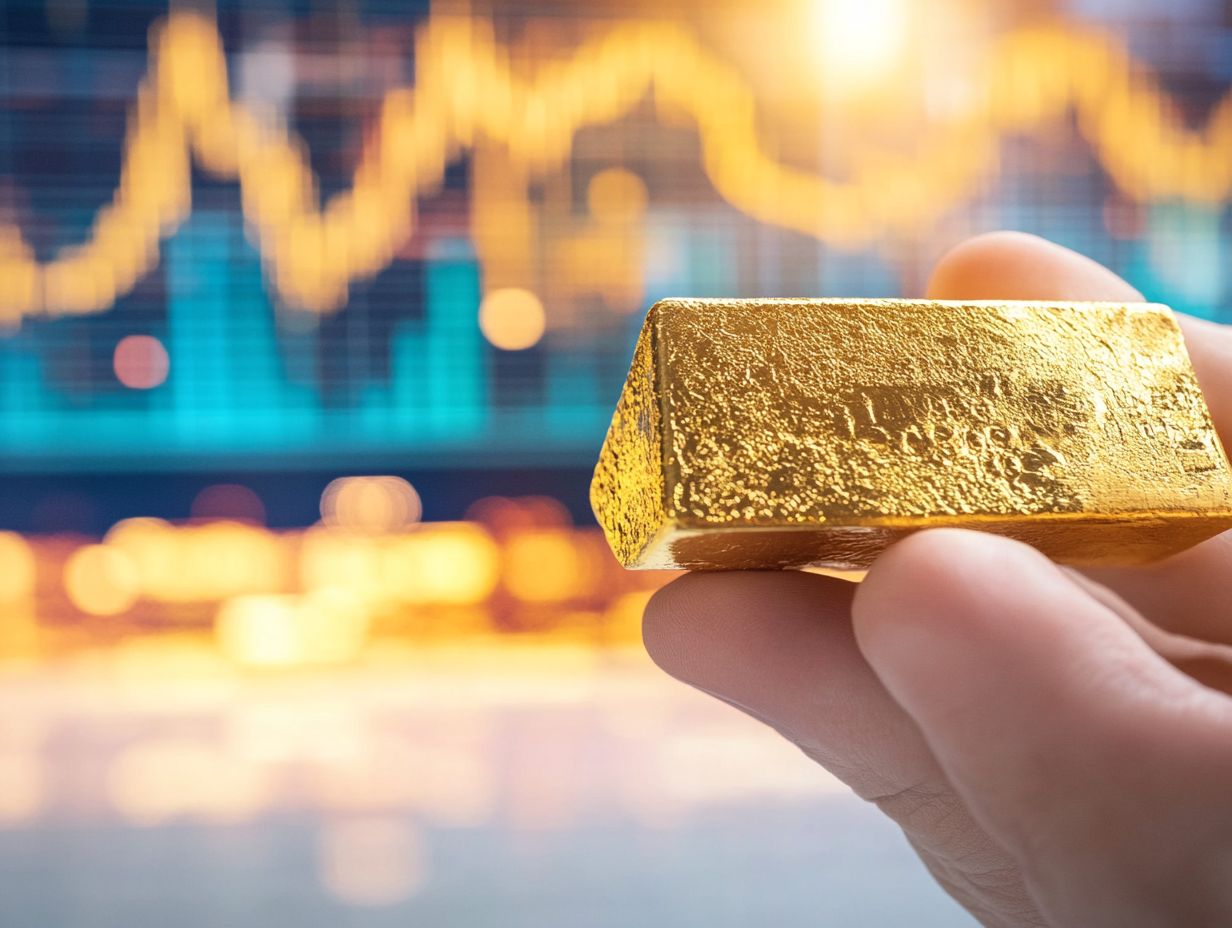
What does the future hold for gold prices? Let s find out! Predictions regarding future gold prices are shaped by expert insights and economic indicators, providing valuable perspectives on potential investment opportunities amid the ever-changing market landscape.
Expert Opinions and Forecasting Methods
Expert opinions and various forecasting methods offer valuable insights into the future trajectory of gold prices, guiding you through complex market conditions.
These techniques combine different analytical approaches that extend beyond simple speculation. Technical analysis is a method where experts look at past prices to predict future trends. Economic indicators, such as inflation rates, unemployment figures, and GDP growth, are crucial for grasping the broader economic landscape.
Central bank activities, such as interest rate changes and management of gold reserves, significantly impact market perceptions. Macro trends, including geopolitical tensions and currency fluctuations, also play a pivotal role in shaping predictions.
With this analysis, you can confidently make smart investment choices based on a thorough understanding of market dynamics.
Final Thoughts and Recommendations
Investing in gold can be a game-changer for your financial security. It’s not just about buying gold; it’s about making informed choices that align with your financial future.
Thoughtful gold investment can significantly enhance your financial security. Keep essential economic factors and market conditions in mind.
This consideration becomes even more critical as you recognize gold s role as protection against inflation and currency fluctuations.
By staying informed about global economic trends, you can make more strategic decisions about when to buy or sell gold.
You need to assess your own risk tolerance and investment goals.
A balanced portfolio might incorporate gold in various forms whether it s bullion, coins, or ETFs (Exchange Traded Funds, which allow you to invest in gold without owning the physical asset) giving you the flexibility to navigate market volatility.
Engaging with financial advisors who understand current trends can empower you to adapt your investment strategies. Ensure they align seamlessly with both your personal objectives and the broader economic landscape.
Frequently Asked Questions
What are some factors that contribute to the rise of gold prices?
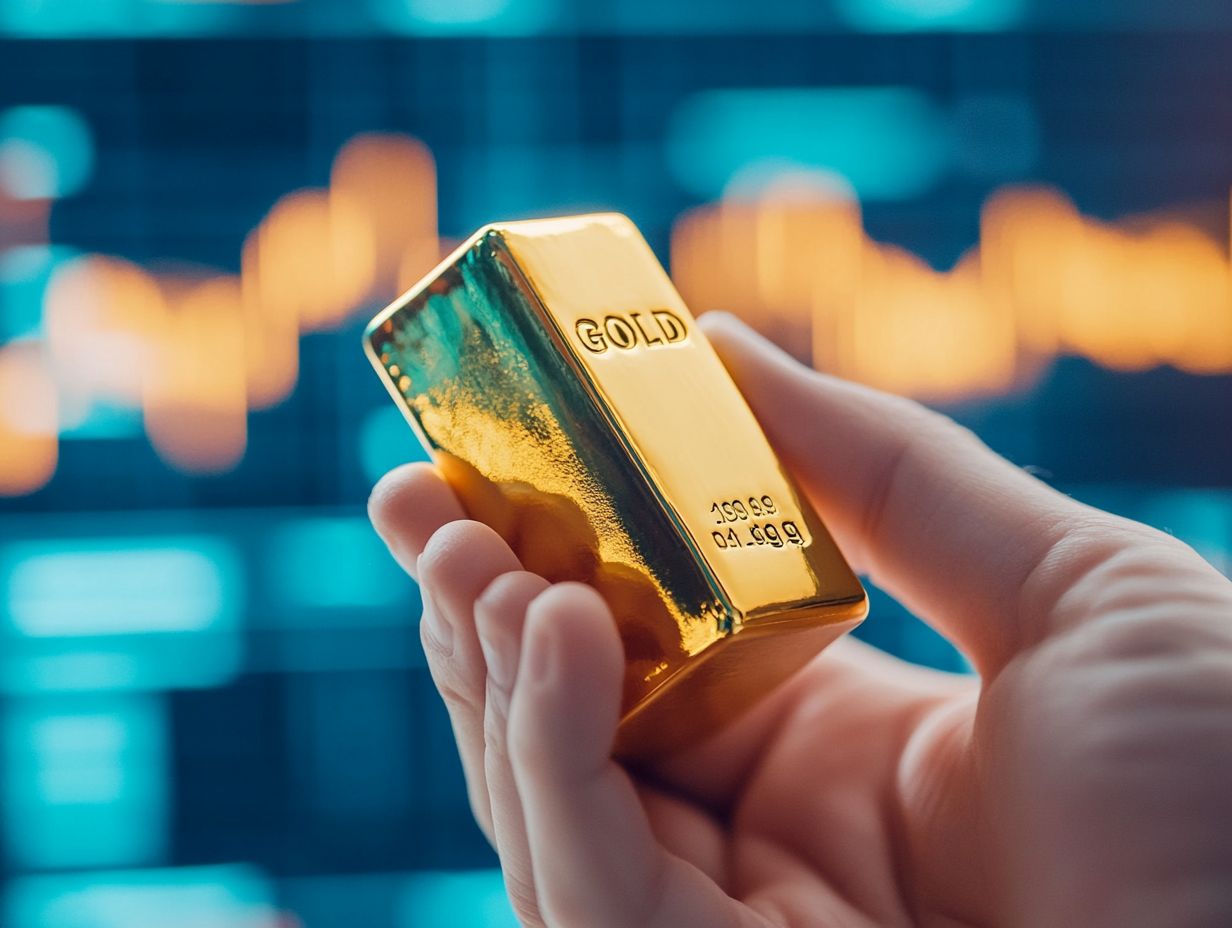
Some factors that contribute to the rise of gold prices include economic uncertainty, inflation, political instability, and demand from investors.
Curious about how economic uncertainty affects gold?
Economic uncertainty, such as a recession or stock market crash, can cause investors to turn to gold as a safe haven asset. This drives up its demand and price.
Discover why inflation matters for gold prices!
Inflation, or the decrease in the value of currency, leads to a rise in gold prices as investors seek to preserve their wealth by investing in a stable asset like gold.
How does political instability impact the rise of gold prices?
Political instability, such as wars or geopolitical tensions, can cause investors to lose confidence in their currency and turn to gold, driving up its value.
Why is demand from investors a significant factor in gold prices?
Investors, both individual and institutional, often turn to gold as a hedge against market volatility and economic uncertainty. This leads to an increase in demand and ultimately, the rise in gold prices.
Are there any other factors to consider when looking at the rise of gold prices?
Other factors that can affect the rise of gold prices include supply and demand from industries such as jewelry and technology, changes in central bank policies, and the value of the US dollar.










